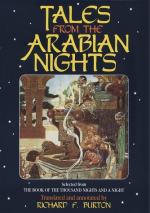Mr. W. F. Thompson, in his translation of the “Ahlak-i-Jalaly,” from the Persian of Fakir Jani Muhammad (15th century), has the following note on the Jam-i-Jamshid and other magical mirrors: “Jamshid, the fourth of the Kaianian dynasty, the Soloman of the Persians. His cup was said to mirror the world, so that he could observe all that was passing elsewhere—a fiction of his own for state purposes, apparently, backed by the use of artificial mirrors. Nizami tells that Alexander invented the steel mirror, by which he means, of course, that improved reflectors were used for telescopy in the days of Archimedes, but not early enough to have assisted Jamshid, who belongs to the fabulous and unchronicled age. In the romance of Beyjan and Manija, in the “Shah Nama,” this mirror is used by the great Khosru for the purpose of discovering the place of the hero’s imprisonment:
“The mirror in his hand revolving shook,
And earth’s whole surface glimmered in his look;
Nor less the secrets of the starry sphere,
The what, the when, the bow depicted clear,
From orbs celestial to the blade of grass,
All nature floated in the magic glass.”
[FN#416] We have been told this king had three daughters.
[FN#417] See in “Blackwood’s Magazine,” vol. iv., 1818, 1819, a translation, from the Danish of J. L. Rasmussen, of “An Historical and Geographical Essay on the trade and commerce of the Arabians and Persians with Russia and Scandinavia during the Middle Ages.—But learned Icelanders, while England was still semi-civilized, frequently made very long journeys into foreign lands: after performing the pilgrimage to Rome, they went to Syria, and some penetrated into Central Asia.
[FN#418] This, of course, is absurd, as each was equally interested in the business; but it seems to indicate a vague reminiscence of the adventures of the Princes in the story of The Envious Sisters.
[FN#419] There is a naivete about this that is particularly refreshing.
[FN#420] This recalls the fairy Meliora, in the romance of Partenopex de Blois. who “knew of ancient tales a countless store.”
[FN#421] In a Norwegian folk-tale the hero receives from a dwarf a magic ship that could enlarge itself so as to contain any number of men, yet could be earned m the pocket.
[FN#422] The Water of Life, the Water of Immortality, the Fountain of Youth—a favourite and wide-spread myth during the Middle Ages. In the romance of Sir Huon of Bordeaux the hero boldly encounters a griffin, and after a desperate fight, in which he is sorely wounded, slays the monster. Close at hand he discovers a clear fountain, at the bottom of which is a gravel of precious stones. “Then he dyde of his helme and dranke of the water his fyll, and he had no sooner dranke therof but incontynent he was hole of all his woundys.” Nothing more frequently occurs in folk tales than for the hero to be required to perform three difficult and dangerous tasks—sometimes impossible, without supernatural assistance.




